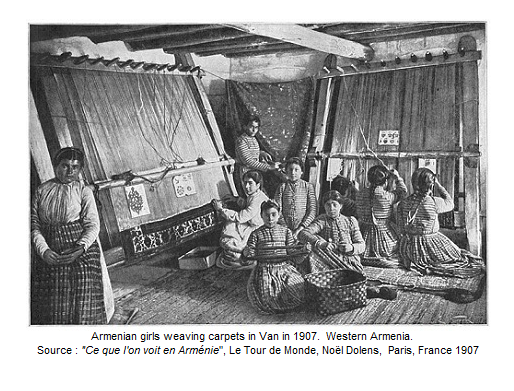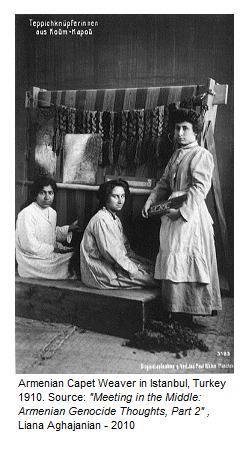The term Armenian carpet designates tufted rugs or knotted carpets woven in Armenia or by Armenians from pre-Christian times to the present. It also includes a number of flat woven textiles. The term covers a large variety of types and sub-varieties. Due to their intrinsic fragility, almost nothing survives - neither carpets nor fragments - from antiquity until the late medieval period. The one ancient carpet that exists, excavated miraculously in the frozen tombs of Siberia, is the famous Pazyryk carpet, dated from the 5th to the 3rd century B.C., now in the Hermitage Museum in St. Petersburg. This square tufted carpet, almost perfectly intact, is considered by many experts of Caucasian, specifically Armenian, origin. The eminent authority of ancient carpets, Ulrich Schurmann, says of it, "From all the evidence available I am convinced that the Pazyryk rug was a funeral accessory and most likely a masterpiece of Armenian workmanship".

Marco Polo and Herodotus are among the many observers and historians who recognized the beauty of Armenian rugs. They noted the rugs' vivid red color which was derived from a dye made from an insect called "ordan" (Arabic "kirmiz"), found in the Mount Ararat valley. The Armenian city of Artashat was famous for its "ordan" dye and was referred to as "the city of the color red" by the Arab historian Yaqut. It is also theorized that the word "carpet", which Europeans used to refer to oriental rugs, is derived from the Armenian word "kapert", meaning woven cloth. The Crusaders, many of whom passed through Armenia, most likely brought this term back to the West. Also, according to Arabic historical sources, the Middle Eastern word for rug, "khali" or "gali", is an abbreviation of "Kalikala", the Arabic name of the Armenian city Karnoy Kaghak. This city, strategically located on the route to the Black Sea port of Trabizond between Persia and Europe, was famous for its Armenian rugs which were prized by the Arabs.
The invention of the Armenian alphabet in 406 A.D. marked the beginning of the golden age in Armenian literature. The writings, paintings, and illuminated manuscripts produced in this era provide insight to the significance of the role of the carpet in Armenian society and oriental rugs in general. The written histories and heroic tales contain references to the Armenian rug. Armenian miniature paintings of royalty and religious scenes as well as the famous illuminated manuscripts also contain many illustrations of Armenian rugs.
 Armenian rugs were status symbols that were placed on the floor or hung on the wall to create an ambiance within the home, palace, or church. Dining on rugs was customary among Armenians and non-Armenians. The numerous kings, emperors, caliphs, sultans, and princes that presided over the Armenians prized these beautiful Armenian rugs and often demanded them as part of a yearly "tax" along with mules, falcons, and salt-fish. Extravagant rugs, woven with gold or silver threads, were placed on the thrones and at the feet of Armenian royalty.
The Armenian Church, which adopted Christianity in 301 A.D., regarded the Armenian rugs as treasures of the church. Although prayer rugs are today associated with Islam, historical references confirm that Armenian prayer rugs were woven by Armenians well before the emergence of Islam in the 7th century. Rugs were also woven to commemorate a special event, such as a royal wedding, or to honor the dead. Rugs were placed on coffins during royal funeral processions and would be buried along with the coffin.
Armenian rugs were status symbols that were placed on the floor or hung on the wall to create an ambiance within the home, palace, or church. Dining on rugs was customary among Armenians and non-Armenians. The numerous kings, emperors, caliphs, sultans, and princes that presided over the Armenians prized these beautiful Armenian rugs and often demanded them as part of a yearly "tax" along with mules, falcons, and salt-fish. Extravagant rugs, woven with gold or silver threads, were placed on the thrones and at the feet of Armenian royalty.
The Armenian Church, which adopted Christianity in 301 A.D., regarded the Armenian rugs as treasures of the church. Although prayer rugs are today associated with Islam, historical references confirm that Armenian prayer rugs were woven by Armenians well before the emergence of Islam in the 7th century. Rugs were also woven to commemorate a special event, such as a royal wedding, or to honor the dead. Rugs were placed on coffins during royal funeral processions and would be buried along with the coffin.
The oldest existing Armenian carpet from the region, referred to as Artsakh during the medieval era, is from the village of Banants (near Gandzak) and dates to the early 13th century. Art historian Hravard Hakobyan notes that "Artsakh carpets occupy a special place in the history of Armenian carpet-making." Common themes and patterns found on Armenian carpets were the depiction of dragons and eagles. They were diverse in style, rich in color and ornamental motifs, and were even separated in categories depending on what sort of animals were depicted on them, such as artsvagorgs (eagle-carpets), vishapagorgs (dragon-carpets) and otsagorgs (serpent-carpets). The art of carpet weaving was in addition intimately connected to the making of curtains as evidenced in a passage by Kirakos Gandzaketsi, a 13th century Armenian historian from Artsakh, who praised Arzu-Khatun, the wife of regional prince Vakhtang Khachenatsi, and her daughters for their expertise and skill in weaving.
 The first time that the Armenian word for carpet, gorg, was used in historical sources was in a 1242-1243 Armenian inscription on the wall of the Kaptavan Church in Artsakh. The rug mentioned in the Kaptavan inscriptions is composed of three arches, "covered with vegatative ornaments", and bears an artistic resemblance to the illuminated manuscripts produced in Artsakh.
The first time that the Armenian word for carpet, gorg, was used in historical sources was in a 1242-1243 Armenian inscription on the wall of the Kaptavan Church in Artsakh. The rug mentioned in the Kaptavan inscriptions is composed of three arches, "covered with vegatative ornaments", and bears an artistic resemblance to the illuminated manuscripts produced in Artsakh.
Carpet-weaving is historically a major traditional profession for the majority of Armenian women, including many Armenian families. Prominent Karabakh carpet weavers there were men too. All of the rugs were woven with wool, which was locally obtainable. Cotton was only used as weft threads and for edging. According to Arthur T. Gregorian, "Armenian rugs are woven firmly with the nap clipped very low, making the rugs supple and soft. A great preference is shown for delicate shades of soft blue, touches of green, coral, old gold, and tans. All the patterns are outlined in either natural brown or wool dyed to this shade". The weavers knew that over time this brown color would fade faster than the other colors, thus it was used for outlining motifs. This color was obtained from the use of an iron pyrite in dyeing the wool. Today, many antique Armenian carpets are widely presented in museum collections in different countries, as well as at auction houses as Anatolian carpets or in the group of Caucasian rugs with very rare reference to their Armenian origin.


Sources and inspiration: Bérinstain, Valérie, et al. L'art du tapis dans le monde (The art of carpets in the world),. Paris: Mengès, 1996. Print.; Jerrehian Jr., Aram K.A. Oriental Rug Primer. Philadelphia: Running Press, 1980. Print.; Herbert, Janice Summers. Oriental Rugs, New York: Macmillan, 1982. Print.; Hackmack, Adolf. Chinese Carpets and Rugs, Rutland and Tokyo: Tuttle, 1980. Print. ; De Moubray, Amicia, and David Black. Carpets for the home, London: Laurence King Publishing, 1999. Print.; Jacobsen, Charles. Oriental Rugs A Complete Guide, Rutland and Tokyo: Tuttle, 1962. Print.; Bashir, S. (n.d.). Personal interview.; Web site sources and dates of consultation vary (to be confirmed). Without prejudice to official usage.


 Tapis d'Orient Bashir | Bashir Persian Rugs
Tapis d'Orient Bashir | Bashir Persian Rugs
 @tapisbashir
@tapisbashir
 @bashircarpets
@bashircarpets
 @bashircarpets
@bashircarpets